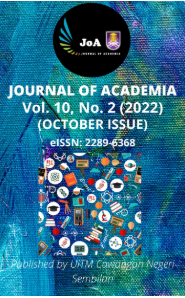POTENTIAL OF GINGER (Zingiber Officinale) CRUDE EXTRACT AS A CHEMOTHERAPEUTIC AGENT FOR NILE TILAPIA (Oreochromis Niloticus) INFECTED BY ACHLYA SP.
Keywords:
Water mould, antimicrobial activity, tilapia juvenile, ginger extract, survival rateAbstract
The outbreaks of Achlya sp. have resulted in enormous mortality of cultured fish and remain a critical
disease problem, resulting in significant losses in aquaculture productivity. Experimental infection of
Nile tilapia (Oreochromis niloticus) juvenile by Achlya sp. was conducted to examine the potential of
ginger crude extract as a chemotherapeutic agent. A total of 100 juveniles were immersed in four
different concentrations of crude ginger extract at 100 ppm, 500 ppm, 800 ppm and 1000 ppm while 0
ppm as the control treatment. The potential of the extract as a treatment agent in the infected fish was
recorded in terms of fish survival rate and changes in physical appearance. The results show that the
treated fish immersed in a lower concentration of ginger extract (100 ppm, 500 ppm and 800 ppm)
possess a higher survival rate and no Achlya sp. found on the fish skin compared to the non-treated
control. The highest concentration of ginger extract at 1000 ppm might be toxic to the fish due to a
lower survival rate compared to other treatments. It shows that ginger crude extract potentially acts as
a chemotherapeutic agent for fungal infection in tilapia juveniles when used in the appropriate
concentration and treatment period.
References
Afzali S.F., Hassan M.D., Abdul-Rahim A.M., Sharifpour I. and Sabri J. (2013). Isolation and identification of
Aphanomyces species from natural water bodies and fish farms in Selangor, Malaysia. Malaysian Applied Biology,
, 21–31.
Alam M., Ahmed G. and Chowdhury M. (2014). Performance of herbal extracts on diseased fish. Bangladesh
Journal of Veterinary Medicine, 12, 225–230.
Ali E.H., Hashem M. and Al-Salahy M.B. (2011). Pathogenicity and oxidative stress in Nile tilapia caused by
Aphanomyces laevis and Phoma herbarum isolated from farmed fish. Diseases of aquatic organisms, 94, 17–28
Atai Z., Atapour M. and Mohseni M. (2009). Inhibitory effect of ginger extract on Candida albicans. American
Journal of Applied Sciences, 6, 1067–1069.
Boonyaratpalin M. and Lovell R.T. (1977). Diet preparation for aquarium fishes. Aquaculture, 12, 53–62.
Chauhan R. (2014). Fungal attack on tilapia mossambicus in culture pond, leading to mass mortality of fishes.
International Journal of Pharmaceutical Sciences and Research, 5, 425–428.
Chong R., Bousfield B. and Brown R. (2011). Fish Disease Management. Veterinary Bulletin - Agriculture,
Fisheries and Conservation Department Newsletter, 1:1–12.
Choudhury, T.G., Singh, S.K., Parhi, J., Barman, D., & Das, B.S. (2014). Common fungal diseases of fish: A
review. Environment & Ecology, 32(2), 450–456.
Duc P.M., Thy D.T.M., Trinh N.T.M., Tuan T.N. and Hatai K. (2016). Water molds isolated from eggs and fry of
Striped Catfish (Pangasianodon hypophthalmus) in the Mekong Delta of Viet Nam. Journal of Fisheries Sciences
, 31–36.
El-Sayed M.E., Algammal A.M., Abouel-Atta M.E., Mabrok M., & Emam A.M. (2019). Pathogenicity, genetic
typing, and antibiotic sensitivity of Vibrio alginolyticus isolated from Oreochromis niloticus and tilapia zillii.
Revue de Medecine Veterinaire, 170(4–6), 80–86.
Fu Y., Wang B., Zhang Q., Xu D., Liu Y., Hou T. and Guo S-Q. (2019). Efficacy and antiparasitic mechanism of
-gingerol isolated from ginger Zingiber officinale against Ichthyophthirius multifiliis in grass carp. Veterinary
Parasitology, 265, 74–84.
Gabriel N.N. (2019). Review on the progress in the role of herbal extracts in tilapia culture. Cogent Food &
Agriculture, 5, 1619651.
Hussein M.M.A, Hassan W.H. and Mahmoud, M.A. (2013). Pathogenicity of Achlya proliferoides and
Saprolegnia diclina (Saprolegniaceae) associated with Saprolegniosis outbreaks in cultured Nile tilapia
(Oreochromis niloticus). World Journal of Fish and Marine Sciences, 5, 188–193.
Jana P., Karmakar S., Roy U., Paul M., Singh A.K. and Bera K.K. (2018). Phytobiotics in aquaculture health
management: A review. Journal of Entomology and Zoology Studies, 6, 1422–1429.
Kigigha L.T. and Kalunta C.G. (2017). Antimicrobial efficacy of leaf extracts of Piper nigrum against Escherichia
coli, Staphylococcus aureus and Candida albicans. J Basic Pharmacol Toxicol, 1, 32–36.
Makori A.J., Abuom P.O., Kapiyo R., Anyona D.N. and Dida G.O. (2017). Effects of water physico-chemical
parameters on tilapia (Oreochromis niloticus) growth in earthen ponds in Teso North Sub-County, Busia County.
Fisheries and Aquatic Sciences, 20, 1–10.
Ming L.L. and Hatai K. (2017). Treatment of Achlya Infection in Freshwater Seabass, Lates calcarifer (Bloch
. Asian Fisheries Science, 30, 130–138.
Panchai K., Hanjavanit C., Rujinanont N., Wada S., Kurata O. and Hatai K. (2015). Experimental pathogenicity
of Achlya species from cultured Nile tilapia to Nile tilapia fry in Thailand. Aquaculture, Aquarium, Conservation
& Legislation, 8, 70–81.
Supreetha S., Mannur S., Simon S.P., Jain J., Tikare S. and Mahuli A. (2011). Antifungal activity of ginger extract
on Candida Albicans: An in-vitro study. Journal of Dental Sciences and Research, 2, 18–21.
Syahidah A., Saad C.R., Daud H.M. and Abdelhadi Y.M. (2015). Status and potential of herbal applications in
aquaculture: A review. Iranian Journal of Fisheries Sciences, 14, 27–44.
Downloads
Published
Issue
Section
License
Copyright (c) 2022 Journal of Academia

This work is licensed under a Creative Commons Attribution-NonCommercial-NoDerivatives 4.0 International License.












